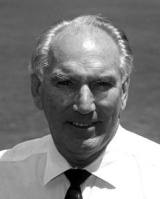Star of the backwoods
John Reid spent weekdays selling fuel to farmers, weekends batting in the local park and holidays playing for New Zealand. Des Wilson celebrates a remarkable allrounder
|
|

|
After Shell appointed Reid its local manager the New Zealand captain could have chosen to drive to the nearest city to play more appropriately competitive cricket. Instead he joined the weakest of the Oamaru clubs. He practised on an uneven concrete wicket at the local park and on Saturdays faced players unable to challenge the power of his batting or the pace of his bowling.
To appreciate Reid's achievement you have to imagine Ian Botham with no county to play for, only the village team on a Saturday; Botham unpaid and with no commercial contracts, with no proper practice wickets and minimal first-class cricket, much of that mediocre; Botham combining the captaincy of his country with running a local Shell depot and, finally, having no world-class team-mates to share the burden of his country's reputation.
For years Reid alone stood between New Zealand and humiliation. Neville Cardus called him "a club cricketer in excelsis" and that is what he was: a club cricketer who from time to time slipped away to do what club cricketers dream of.
His greatness is not fully reflected by the statistics, impressive as they are. He averaged over 40 in 246 first-class games, most of them for the national side, and took 466 wickets at 22.60; he also played 58 Tests, averaging 33 and taking 85 wickets. What those figures conceal is how many momentous performances were produced in desperate circumstances or when Reid was virtually without support. In 1951, for instance, he scored a century for Wellington while the remaining 10 players contributed 39.
Like Botham (and Keith Miller), Reid habitually scored runs when they were most needed and took wickets or a blinding catch at just the right time. He was that kind of cricketer - an aggressive allrounder who made things happen. The best of all New Zealand cricket writers, RT Brittenden, wrote that Reid was "never more dangerous than when his back was to the wall ... he breathed life into a game by his very presence".
Shortly after Reid came to Oamaru I was one of a handful who gathered on a Saturday morning to bowl at him so that he could prepare for New Zealand's 1955-56 tour of India and Pakistan. As he politely and sensitively patted back this 14-year-old's innocuous slow medium-pacers he must have wondered how on earth this could be described as "preparing". Yet in the first match of that tour, in Karachi, coming from the chill of a South Island winter to steamy heat, he took for 7 for 28 and scored 150 not out. It was a difficult tour, yet in first-class games Reid hit 1,032 runs, averaging more than 50, and took 39 wickets.
The following season, while still in Oamaru, he led New Zealand to their first Test victory - over West Indies at Auckland. That ended 26 winless and painful years, in which they played 44 Tests. What a moment for Kiwi cricket.
Reid performed well on his first two England tours. He was 20 when chosen to tour as reserve wicketkeeper in 1949, but he scored nearly 1,500 runs and forced his way into the Test team, where he thrived. He scored another 1,500 on the 1958 tour. But Reid's best performances were reserved for South Africa, in 1961-62, when he led his side to two Test wins, hit seven tour centuries in nine innings and scored more Test runs than any two of his colleagues.
Sprinkled throughout that time there were some memorable Plunket Shield moments. At a time when officials elsewhere in the world were pushing for "brighter cricket" Reid was a one-man sunbeam, with the best moment of all a stunning 296 for Wellington in 1962-63 - with 15 sixes, a world record until 1995.
For 10 years he carried the weight of leading a sub-standard Test team. When he eventually retired he had appeared in 58 of New Zealand's 86 Tests and led them in 36. His acceptance without complaint of the burdens thrust upon him, his modesty, his courage and his skill built the foundations that Hadlee, Crowe, Turner and others were later to build on.
Now in his 70s, having been for a while a respected international referee, Reid lives quietly on the North Island. Does he ever wonder what he could have achieved at a different time or in a different place? The answer must be much more. But thank God for New Zealand cricket that John Reid was a New Zealander.
One last memory of Reid: as he walked without celebrity down the main street of Oamaru, a 14-year-old approached him with a piece of paper containing his "selection" for the New Zealand team for an upcoming Test. Reid solemnly studied it and made one or two comments, before assuring the boy his suggestions would be fully considered by him and the other selectors. I have never forgotten the thrill of that moment. And I will never forget John Reid.
Wilson is a former chairman of the ECB corporate affairs and marketing committee
